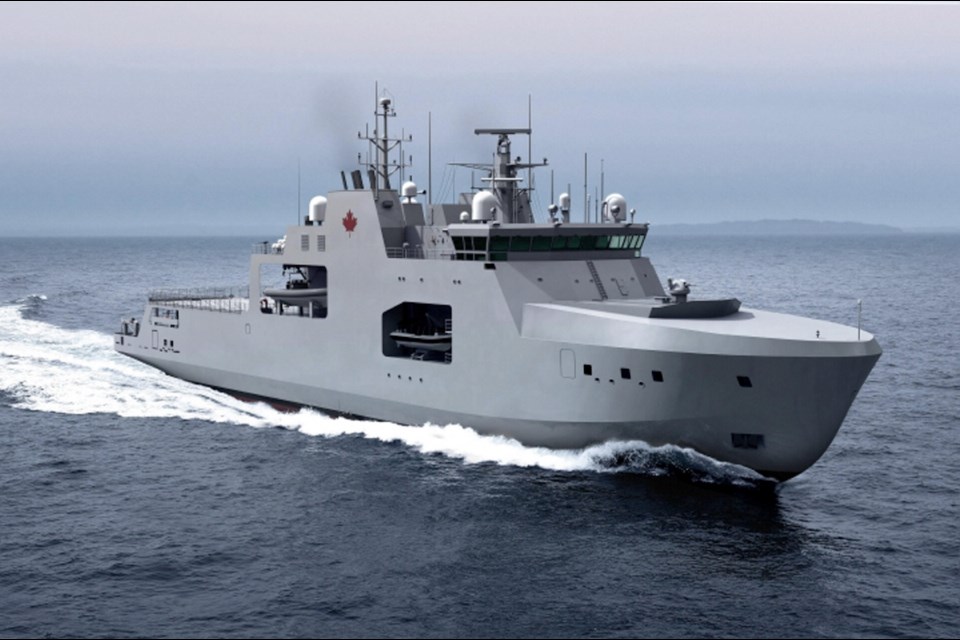Chief petty officer Max Bernays was a coxswain at the helm of HMCS Assiniboine during the Battle of the Atlantic on Aug. 6, 1942, when enemy gunfire caused a fire in the bridge and wheelhouse. Bernays sent two junior sailors clear of the smoke and flames, and as bullets and shells from machine gun and cannon fire pierced the wheelhouse, he was able to send the orders that drove the ship into the German submarine, sinking it.
The Colwood resident, who died in 1974, didn’t talk much about what happened in that attack, where one Canadian died and 13 were injured, but his courage will be remembered, thanks to a Canadian navy ship that will bear his name.
Her Majesty’s Canadian Ship Max Bernays is one in a fleet of six Arctic and offshore patrol ships named after naval heroes.
“It’s so well-deserved — he was a hero,” said his daughter-in-law Marilyn Bernays, who was joined by one of Max Bernays’ granddaughters and eight of his nine great-grandchildren as the name was announced by Julian Fantino, associate minister of national defence, at CFB Esquimalt on Monday.
“He was very proud of what he did, but he never talked about it,” said Marilyn Bernays, who was married to Bernays’ late son, Max Jr. “I think he’d be very humbled but very happy.”
Born in 1910 in Vancouver to a seafaring family, Bernays joined the naval reserves in 1929, serving with the Canadian National Steamships in the 1930s until he was recalled by the navy at the outbreak of the Second World War.
HMCS Assiniboine was part of a convoy laden with cargo heading to Britain when six or seven German U-boats closed in for an attack. Assiniboine’s radar tracked one submarine, U-210, in the fog and went in pursuit.
The two vessels played a high-stakes game of hide-and-seek in the heavy fog, leading to both opening fire at close range. That sparked the fire that engulfed the bridge and parts of the forecastle.
Bernays ordered the two junior sailors working as telegraph men to clear the bridge, and dispatched more than 130 telegraph orders to the engine room, allowing the destroyer to ram the submarine three times and sink it.
HMCS Assiniboine and HMS Dianthus rescued 38 of the 48 German crew.
While Bernays was not seriously injured, the battle left him with shell fragments and splinters permanently embedded in his temple.
Bernays was originally recommended for the Victoria Cross, but was instead awarded the Conspicuous Gallantry medal by the British Admiralty for his courage, making him one of only two members of the Royal Canadian Navy to receive the honour during the Second World War.
Bernays went on to provide security for Canadian embassies in Yugoslavia, Germany and England before retiring in Colwood, where his family now lives.
Bernays’ son, Max Jr., followed in his father’s footsteps and joined the navy at 17.
“My husband would be beside himself, he would be very happy,” Marilyn Bernays said.
The ships are part of the National Shipbuilding Procurement Strategy, a $33-billion project to build 29 ships for the navy and coast guard during the next two to three decades.
The Arctic offshore patrol ships are being named in honour of prominent Canadian heroes who served in the Royal Canadian Navy.
Last month, the government announced one of the ships would be named after Margaret Brooke, a 100-year-old Victoria resident who tried to save the life of a fellow nurse as she hung onto the ropes of a capsized lifeboat, after their ferry was torpedoed by a German submarine off the coast of Newfoundland in the midst of the Second World War.
Construction on the Arctic patrol ships, being built by Halifax Shipyards as part of a $2.6-billion contract, is set to begin this fall.



